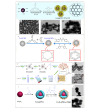[Recent progress in magnetic covalent organic framework materials for the enrichment and detection of typical organic pollutants]
- PMID: 39844701
- PMCID: PMC11758229
- DOI: 10.3724/SP.J.1123.2024.07020
[Recent progress in magnetic covalent organic framework materials for the enrichment and detection of typical organic pollutants]
Abstract
Trace contaminants are toxic and their widespread presence in the environment potentially threatens human health. The levels of these pollutants are often difficult to determine directly using instruments owing to the complexities of environment matrices. Hence, pretreatment steps, such as sample purification and concentration, are key along with various processes that enhance the accuracy and sensitivity of the detection method. To date, researchers have successfully developed a variety of efficient and reliable sample-pretreatment techniques that are based on different principles. Among these, magnetic solid-phase extraction (MSPE) is a rapid and efficient sample-pretreatment technology that is based on the similar solid-phase-extraction (SPE) principle, which mainly enriches target analytes by exploiting their interactions with functional groups on the surfaces of magnetic materials, thereby achieving rapid separation when an external magnetic field is applied. MSPE has been a focus of attention in the environmental-sample-pretreatment, food-analysis, and other fields owing to advantages that include ease of operation, low cost, and high enrichment efficiency. The selection of the magnetic material is key to MSPE process because traditional magnetic materials exhibit certain functionality limitations. Accordingly, designing and synthesizing green and efficient functionalized magnetic materials have become a research focus in this field, with researchers having extensively explored multiple ways of preparing functionalized modified magnetic materials through the introduction of a variety of emerging materials, including metal-organic frameworks (MOFs), covalent organic frameworks (COFs), carbon nanotubes (CNTs), graphene oxide (GO), and other specific functional groups to modify magnetic materials and effectively expanded the applications scope of MSPE. Among these, COFs are porous crystalline materials consisting of light elements (C, N, H, O and B, etc.) linked through covalent bonds. COFs are mainly classified as imine COFs, boronic-acid COFs, triazine COFs, and ketenimine COFs according to bonding type. Moreover, it is worth mentioning that COFs can be synthesized from a number of monomers, and the functional groups exposed on the COF surface can also be used for further modification purposes. COFs are versatile and modifiable; consequently, they have attracted significant research attention, with a series of COF-functionalized magnetic materials having been designed and synthesized. The magnetic COFs (MCOFs) combine the advantages of COFs and magnetic materials. MCOFs are not only endowed with the large specific surface areas, high porosities, and good stabilities that are characteristic of COFs, but also exhibit the rapid separation and reusability characteristics of magnetic material, thereby quickly and efficiently enriching targets through hydrogen bonding, hydrophobicity, π-π stacking, and van der Waals forces, making them ideal sample-pretreatment materials. MCOFs have also been converted into more-versatile functional materials using post-modification strategies. Combining MCOFs with advanced analytical techniques, such as high performance liquid chromatography (HPLC) and gas chromatography-mass spectrometry (GC-MS) has effectively improved the limits of detection (LODs) for various analytes as well as method accuracy; these techniques have been widely used to enrich and detect trace pollutants. However, some material design and synthesis challenges remain and need to be overcome, despite the promising potential of MCOFs. Future research needs to focus on exploring novel synthetic strategies that reduce experimental costs and improve the functionalities of MCOFs while expanding their applicabilities to broader sample matrices. In this review, we first introduce and discuss the construction and functionalized designs of various MCOF composites, and then summarize their use in applications that include the enrichment and detection of pesticides, endocrine disruptors (EDCs), pharmaceuticals, and personal care products (PPCPs), and finally provide an outlook on future developmental prospects.
痕量污染物因其在环境中的微量存在和基质的复杂性,难以直接通过仪器进行检测,对人类的健康构成潜在威胁。磁性固相萃取(MSPE)技术因具有操作简单、成本低廉、富集效率高等优势,在样品前处理领域一直备受关注。磁性固相萃取的研究聚焦于磁性材料的功能化,近年来研究者深入探索了磁性材料的功能化途径,将多种新兴材料引入磁性材料的修饰,有效拓展了磁性功能化材料的性能和应用领域。其中,磁性共价有机骨架材料(MCOFs)是一种具有代表性的材料,不仅具有比表面积大、稳定性高的特点,还兼具磁性材料的快速分离特性;可通过氢键作用、疏水作用、π-π共轭作用实现对目标物的快速、高效富集。本文重点综述了MCOFs的种类、合成方法及其在富集检测农药、内分泌干扰物(EDCs)及药物和个人护理产品(PPCPs)中的应用,并对该领域未来研究的发展方向进行了展望。
Keywords: endocrine disruptors (EDCs); magnetic covalent organic framework (MCOFs); magnetic solid-phase extraction (MSPE); pesticide; pharmaceutical and personal care products (PPCPs); review.
Figures



Similar articles
-
Gadolinium Magnetic Resonance Imaging.2023 Jul 3. In: StatPearls [Internet]. Treasure Island (FL): StatPearls Publishing; 2025 Jan–. 2023 Jul 3. In: StatPearls [Internet]. Treasure Island (FL): StatPearls Publishing; 2025 Jan–. PMID: 29494094 Free Books & Documents.
-
Chromatography.2024 Jan 11. In: StatPearls [Internet]. Treasure Island (FL): StatPearls Publishing; 2025 Jan–. 2024 Jan 11. In: StatPearls [Internet]. Treasure Island (FL): StatPearls Publishing; 2025 Jan–. PMID: 38261673 Free Books & Documents.
-
Exploring conceptual and theoretical frameworks for nurse practitioner education: a scoping review protocol.JBI Database System Rev Implement Rep. 2015 Oct;13(10):146-55. doi: 10.11124/jbisrir-2015-2150. JBI Database System Rev Implement Rep. 2015. PMID: 26571290
-
Ethics of Procuring and Using Organs or Tissue from Infants and Newborns for Transplantation, Research, or Commercial Purposes: Protocol for a Bioethics Scoping Review.Wellcome Open Res. 2024 Dec 5;9:717. doi: 10.12688/wellcomeopenres.23235.1. eCollection 2024. Wellcome Open Res. 2024. PMID: 39839977 Free PMC article.
-
Depressing time: Waiting, melancholia, and the psychoanalytic practice of care.In: Kirtsoglou E, Simpson B, editors. The Time of Anthropology: Studies of Contemporary Chronopolitics. Abingdon: Routledge; 2020. Chapter 5. In: Kirtsoglou E, Simpson B, editors. The Time of Anthropology: Studies of Contemporary Chronopolitics. Abingdon: Routledge; 2020. Chapter 5. PMID: 36137063 Free Books & Documents. Review.
References
-
- Zhou Q, Zhao K, Wu Y, et al.. Chemosphere, 2021, 281: 130900 - PubMed
-
- Razak M R, Aris A Z, Sukatis F F, et al.. J Sep Sci, 2023, 46(1): 2200282 - PubMed
-
- Montemurro N, Postigo C, Lonigro A, et al.. Anal Bioanal Chem, 2017, 409(23): 5375 - PubMed
-
- Su D, Li W, Xu Q, et al.. Fitoterapia, 2016, 112: 45 - PubMed
Publication types
LinkOut - more resources
Full Text Sources
Research Materials
Miscellaneous
